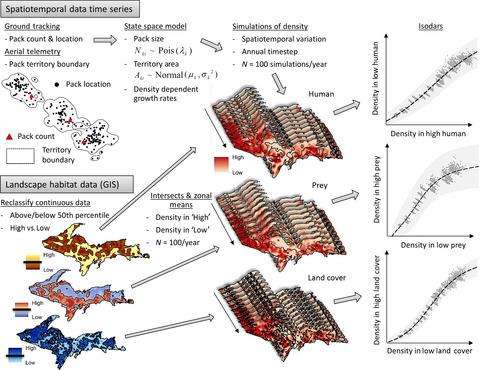当前位置:
X-MOL 学术
›
J. Anim. Ecol.
›
论文详情
Our official English website, www.x-mol.net, welcomes your
feedback! (Note: you will need to create a separate account there.)
Territoriality drives preemptive habitat selection in recovering wolves: implications for carnivore conservation
Journal of Animal Ecology ( IF 3.5 ) Pub Date : 2020-03-07 , DOI: 10.1111/1365-2656.13199 Shawn T O'Neil 1 , John A Vucetich 1 , Dean E Beyer 1, 2 , Sarah R Hoy 1 , Joseph K Bump 3
Journal of Animal Ecology ( IF 3.5 ) Pub Date : 2020-03-07 , DOI: 10.1111/1365-2656.13199 Shawn T O'Neil 1 , John A Vucetich 1 , Dean E Beyer 1, 2 , Sarah R Hoy 1 , Joseph K Bump 3
Affiliation

|
According to the ideal-free distribution (IFD), individuals within a population are free to select habitats that maximize their chances of success. Assuming knowledge of habitat quality, the IFD predicts that average fitness will be approximately equal among individuals and between habitats, while density varies, implying that habitat selection will be density dependent. Populations are often assumed to follow an IFD, although this assumption is rarely tested with empirical data, and may be incorrect when territoriality indicates habitat selection tactics that deviate from the IFD (e.g. ideal despotic distribution or ideal preemptive distribution). When territoriality influences habitat selection, species' density will not directly reflect components of fitness such as reproductive success or survival. In such cases, assuming an IFD can lead to false conclusions about habitat quality. We tested theoretical models of density-dependent habitat selection on a species known to exhibit territorial behavior in order to determine whether commonly applied habitat models are appropriate under these circumstances. We combined long-term radio telemetry and census data from gray wolves (Canis lupus) in the Upper Peninsula of Michigan, USA to relate spatiotemporal variability in wolf density to underlying classifications of habitat within a hierarchical state-space modeling framework. We then iteratively applied isodar analysis to evaluate which distribution of habitat selection best described this recolonizing wolf population. The wolf population in our study expanded by >1000% during our study (~ 50 to > 600 individuals), and density-dependent habitat selection was most consistent with the ideal preemptive distribution, as opposed to the ideal-free or ideal-despotic alternatives. Population density of terrestrial carnivores may not be positively correlated with the fitness value of their habitats, and density-dependent habitat selection patterns may help to explain complex predator-prey dynamics and cascading indirect effects. Source-sink population dynamics appear likely when species exhibit rapid growth and occupy interspersed habitats of contrasting quality. These conditions are likely and have implications for large carnivores in many systems, such as areas in North America and Europe where large predator species are currently recolonizing their former ranges.
中文翻译:

在恢复狼群时,地域性推动先发制人的栖息地选择:对食肉动物保护的影响
根据理想自由分布 (IFD),种群中的个体可以自由选择能够最大限度地提高成功机会的栖息地。假设了解栖息地质量,IFD 预测个体之间和栖息地之间的平均适应度将大致相等,而密度不同,这意味着栖息地选择将取决于密度。通常假设种群遵循 IFD,尽管这一假设很少用经验数据进行检验,并且当领土表明栖息地选择策略偏离 IFD 时(例如,理想的专制分布或理想的先发制人分布)可能是不正确的。当领土性影响栖息地选择时,物种的密度不会直接反映适应性的组成部分,例如繁殖成功或生存。在这种情况下,假设 IFD 会导致关于栖息地质量的错误结论。我们在已知表现出领土行为的物种上测试了密度依赖栖息地选择的理论模型,以确定通常应用的栖息地模型在这些情况下是否合适。我们将来自美国密歇根州上半岛的灰狼 (Canis lupus) 的长期无线电遥测和人口普查数据结合起来,将狼密度的时空变异与分层状态空间建模框架内的栖息地基本分类联系起来。然后,我们反复应用等值线分析来评估哪种栖息地选择分布最能描述这种重新定殖的狼群。在我们的研究期间,我们研究中的狼群增加了 > 1000%(约 50 至 > 600 只),与密度相关的栖息地选择与理想的先发制人分布最一致,而不是理想的自由或理想的专制替代方案。陆生食肉动物的种群密度可能与其栖息地的适应值不呈正相关,而密度依赖的栖息地选择模式可能有助于解释复杂的捕食者-猎物动态和级联间接影响。当物种表现出快速增长并占据散布的质量相反的栖息地时,可能会出现源汇种群动态。这些条件很可能对许多系统中的大型食肉动物产生影响,例如北美和欧洲的大型食肉动物物种目前正在重新定居它们以前的范围。与理想的自由或理想的专制替代方案相反。陆生食肉动物的种群密度可能与其栖息地的适应值不呈正相关,而密度依赖的栖息地选择模式可能有助于解释复杂的捕食者-猎物动态和级联间接影响。当物种表现出快速增长并占据散布的质量相反的栖息地时,可能会出现源汇种群动态。这些条件很可能对许多系统中的大型食肉动物产生影响,例如北美和欧洲的大型食肉动物物种目前正在重新定居它们以前的范围。与理想的自由或理想的专制替代方案相反。陆生食肉动物的种群密度可能与其栖息地的适应值不呈正相关,而密度依赖的栖息地选择模式可能有助于解释复杂的捕食者-猎物动态和级联间接影响。当物种表现出快速增长并占据散布的质量相反的栖息地时,可能会出现源汇种群动态。这些条件很可能对许多系统中的大型食肉动物产生影响,例如北美和欧洲的大型食肉动物物种目前正在重新定居它们以前的范围。和密度相关的栖息地选择模式可能有助于解释复杂的捕食者-猎物动态和级联间接影响。当物种表现出快速增长并占据散布的质量相反的栖息地时,可能会出现源汇种群动态。这些条件很可能对许多系统中的大型食肉动物产生影响,例如北美和欧洲的大型食肉动物物种目前正在重新定居它们以前的范围。和密度相关的栖息地选择模式可能有助于解释复杂的捕食者-猎物动态和级联间接影响。当物种表现出快速增长并占据散布的质量相反的栖息地时,可能会出现源汇种群动态。这些条件很可能对许多系统中的大型食肉动物产生影响,例如北美和欧洲的大型食肉动物物种目前正在重新定居它们以前的范围。
更新日期:2020-03-07
中文翻译:

在恢复狼群时,地域性推动先发制人的栖息地选择:对食肉动物保护的影响
根据理想自由分布 (IFD),种群中的个体可以自由选择能够最大限度地提高成功机会的栖息地。假设了解栖息地质量,IFD 预测个体之间和栖息地之间的平均适应度将大致相等,而密度不同,这意味着栖息地选择将取决于密度。通常假设种群遵循 IFD,尽管这一假设很少用经验数据进行检验,并且当领土表明栖息地选择策略偏离 IFD 时(例如,理想的专制分布或理想的先发制人分布)可能是不正确的。当领土性影响栖息地选择时,物种的密度不会直接反映适应性的组成部分,例如繁殖成功或生存。在这种情况下,假设 IFD 会导致关于栖息地质量的错误结论。我们在已知表现出领土行为的物种上测试了密度依赖栖息地选择的理论模型,以确定通常应用的栖息地模型在这些情况下是否合适。我们将来自美国密歇根州上半岛的灰狼 (Canis lupus) 的长期无线电遥测和人口普查数据结合起来,将狼密度的时空变异与分层状态空间建模框架内的栖息地基本分类联系起来。然后,我们反复应用等值线分析来评估哪种栖息地选择分布最能描述这种重新定殖的狼群。在我们的研究期间,我们研究中的狼群增加了 > 1000%(约 50 至 > 600 只),与密度相关的栖息地选择与理想的先发制人分布最一致,而不是理想的自由或理想的专制替代方案。陆生食肉动物的种群密度可能与其栖息地的适应值不呈正相关,而密度依赖的栖息地选择模式可能有助于解释复杂的捕食者-猎物动态和级联间接影响。当物种表现出快速增长并占据散布的质量相反的栖息地时,可能会出现源汇种群动态。这些条件很可能对许多系统中的大型食肉动物产生影响,例如北美和欧洲的大型食肉动物物种目前正在重新定居它们以前的范围。与理想的自由或理想的专制替代方案相反。陆生食肉动物的种群密度可能与其栖息地的适应值不呈正相关,而密度依赖的栖息地选择模式可能有助于解释复杂的捕食者-猎物动态和级联间接影响。当物种表现出快速增长并占据散布的质量相反的栖息地时,可能会出现源汇种群动态。这些条件很可能对许多系统中的大型食肉动物产生影响,例如北美和欧洲的大型食肉动物物种目前正在重新定居它们以前的范围。与理想的自由或理想的专制替代方案相反。陆生食肉动物的种群密度可能与其栖息地的适应值不呈正相关,而密度依赖的栖息地选择模式可能有助于解释复杂的捕食者-猎物动态和级联间接影响。当物种表现出快速增长并占据散布的质量相反的栖息地时,可能会出现源汇种群动态。这些条件很可能对许多系统中的大型食肉动物产生影响,例如北美和欧洲的大型食肉动物物种目前正在重新定居它们以前的范围。和密度相关的栖息地选择模式可能有助于解释复杂的捕食者-猎物动态和级联间接影响。当物种表现出快速增长并占据散布的质量相反的栖息地时,可能会出现源汇种群动态。这些条件很可能对许多系统中的大型食肉动物产生影响,例如北美和欧洲的大型食肉动物物种目前正在重新定居它们以前的范围。和密度相关的栖息地选择模式可能有助于解释复杂的捕食者-猎物动态和级联间接影响。当物种表现出快速增长并占据散布的质量相反的栖息地时,可能会出现源汇种群动态。这些条件很可能对许多系统中的大型食肉动物产生影响,例如北美和欧洲的大型食肉动物物种目前正在重新定居它们以前的范围。











































 京公网安备 11010802027423号
京公网安备 11010802027423号